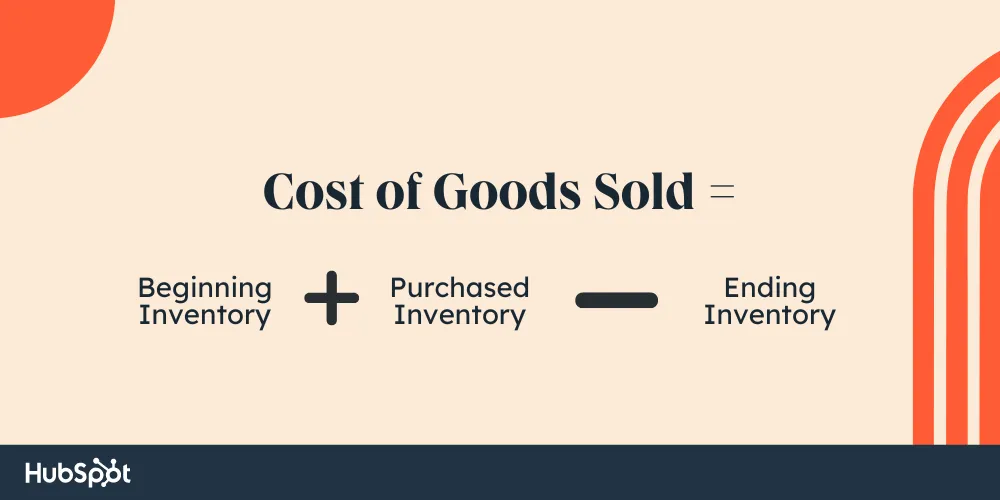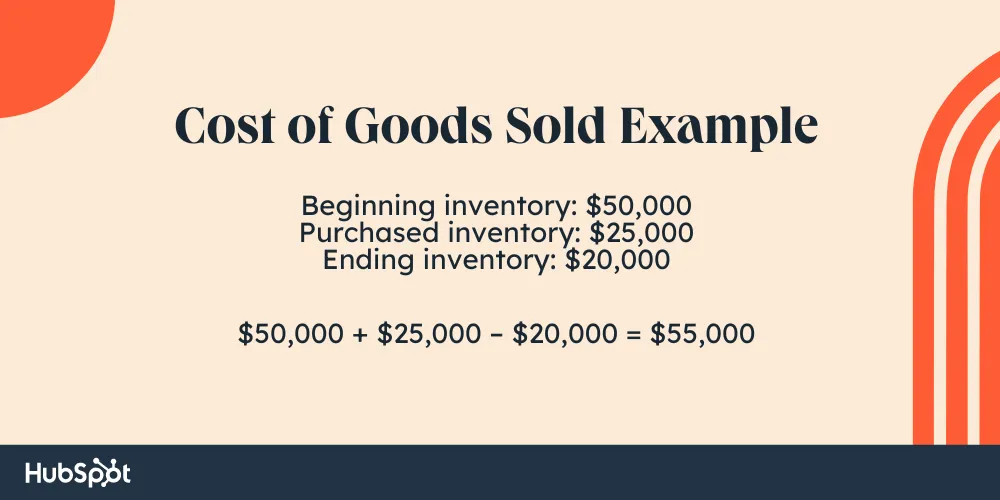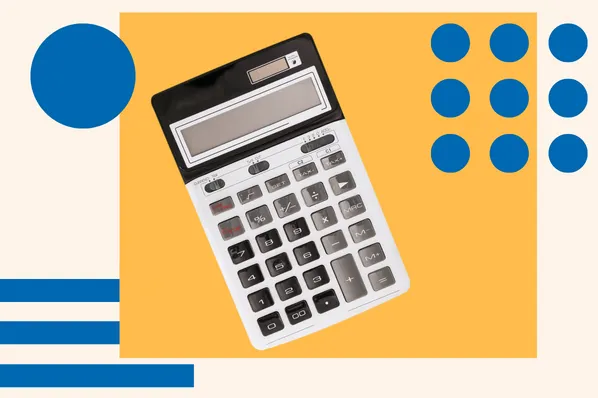What is Cost of Goods Sold?
COGS is a business and sales metric that determines the value of inventory sold (and created, if you’re the manufacturer) in a specific time. The formula looks at all costs directly related to your inventory, including raw materials, transportation, storage, and direct labor for manufacturers.
Because COGS tells business owners how much it costs to acquire your products, the number ties directly back to profit and revenue. For example, if your COGS is the same as or lower than your revenue for that period, it means you’ve broken even or have lost money and are not profitable.
To benchmark, businesses should look at their COGS for a specific time period (a day, a quarter, a year, etc.) and compare it to a different time period of the same length to see how sales changed.
Cost of Goods Sold Formula

To calculate COGS, follow this simple formula: Cost of Goods Sold = Beginning Inventory + Purchased Inventory – Ending Inventory
So, let’s imagine that you’re crunching your quarterly numbers. You started Q4 with $50,000 in inventory, and you purchased an additional $25,000 in inventory to keep up with holiday demand. At the end of the quarter, you have $20,000 of inventory remaining.
COGS = $50,000 + $25,000 – $20,000
In this case, your COGS for the quarter comes out to $55,000. Calculating COGS varies based on whether you are the manufacturer or the retailer, so let’s walk through both to make things clear.

Cost of Goods Sold Formula for Retailers
If you’re a middleman or retailer, COGS is fairly straightforward. Think of COGS as all of your costs associated with the inventory itself. Here are items you can include in COGS:
- Direct cost of products
- Sales tax
- Freight
- Warehousing and storage
- Product labeling and packaging
Expenses associated with overhead, such as labor, administrative software, marketing, and shipping to customers, can’t be classified as COGS.
Cost of Goods Sold Formula for Manufacturers
Product manufacturers have a more complex approach to calculating COGS. The raw materials and overhead with your factory or warehouse all play a role in your production cost, including:
- Raw materials and parts
- Labor for production and warehousing
- Packaging and labeling
- Factory overhead, including equipment and building costs
Like retailers, manufacturers need to exclude certain administrative expenses from COGS. Building costs, in particular, can be tricky as some but not all expenses can be counted in COGS. Work with a trusted accountant for specific guidance to make sure you get it right.
Cost of Goods Sold Calculator
To calculate your COGS number without running sums by hand, use a cost of goods sold calculator.
HubSpot’s sales metrics calculator is a free spreadsheet where you can plug in numbers to see your key metrics, including COGS, customer acquisition cost (CAC), average win rate, and customer retention rate.
 Download this Calculator for Free
Download this Calculator for Free
How to Report COGS on an Income Statement
One of the primary purposes of tracking COGS is so that you can write it off on your taxes. Each time you incur an expense related to inventory, create a journal entry on your books with the correct expense category. When you pull a profit and loss (P&L) sheet, your COGS will appear on the income statement underneath sales.
|
Jan |
Feb |
|
|
Income |
||
|
Sales |
$10,100 |
$12,250 |
|
Cost of Goods Sold |
$5,600 |
$5,750 |
|
GROSS PROFIT |
$4,500 |
$6,500 |
At the end of each quarter or time period, use your accounting software or the cost of goods sold formula above to calculate COGS. Re-verify your goods purchased, goods sold, and current inventory in order to look for loss or theft.
Cost of Goods Sold Examples
Example for Retailers
Let’s take the example of a backpack for a school supply store. Say that you had $10,000 worth of backpacks at the start of the month, but it’s the last month of summer vacation, and so the store stocks up on an additional $20,000 worth of backpacks. At the end of the month, they have just $2,000 worth of backpacks to be sold to their customers.
The variables are:
- Beginning Inventory = $10,000
- Purchased Inventory = $20,000
- Ending Inventory = $2,000
Time to crunch some numbers!
- Cost of Goods Sold = Beginning Inventory + Purchased Inventory – Ending Inventory
- Cost of Goods Sold = $10,000 + $20,000 – $2,000
- Cost of Goods Sold = $28,000
This means that the total amount directly traceable to the backpacks the store had to spend was $28,000.
Where COGS can get layered for retail stores and distributors is with different product lines. Businesses like grocery stores and hardware stores have thousands of different products on their shelves, so tracing what specifically caused COGS to go up or down can be difficult.
Example for Manufacturers
Let’s imagine that instead of selling backpacks, you manufacture them. Think of everything that goes into making one: the metal for zippers, the cloth, the plastic for securing the straps, the tags, and even the labor hours directly traceable to production.
To calculate the COGS for your backpacks in this example, you need to total the amount of inventory in your possession at the start of the time frame.
Let’s say that it’s a one-month period. On the first day of the month, the company has a beginning inventory of backpacks that cost $1,000,000 to manufacture from material and labor.
Throughout the time period, the company produces an additional batch of backpack-making materials at a cost of $700,000, broken down as follows:
- $400,000 on the cloth for the backpacks.
- $200,000 on metal for zippers.
- $50,000 on the plastic for securing the straps.
- $50,000 on the hourly wages of the warehouse workers responsible for producing the products.
At the end of the month, the company has a remaining inventory of backpacks that cost $500,000 to make.
So, let’s identify the variables in this situation:
- Beginning Inventory = $1,000,000
- Purchased Inventory = $700,000
- Ending Inventory = $500,000
Now, plug them into the cost of goods sold formula:
- Cost of Goods Sold = Beginning Inventory + Purchased Inventory - Ending Inventory
- Cost of Goods Sold = $1,000,000 + $700,000 – $500,000
- Cost of Goods Sold = $1,200,000
This means the manufacturer’s total number of backpacks sold during this month cost $1,200,000 to produce.
Cost of Goods Sold Best Practices
Since COGS is so crucial to your business, making efforts to optimize it can pay off in many ways. Here are a few of our recommendations for controlling your cost of goods sold.
1. Work out deals with suppliers.
Suppliers are often willing to negotiate on the price of what they sell you if you can buy in bulk, commit to an exclusive agreement, or sign onto a long-term partnership. If you’re able to do this, you can lower the cost of this inventory and keep the price to your customers the same, resulting in more profit for you and no difference in price or quality for customers.
What we like: It can take a while to find the right vendors and build a level of trust and partnership. If successful, these relationships can be a huge money saver for your business.
2. Organize COGS by category.
While looking at COGS over time provides clear projections of growth and sustainability of the business, it doesn’t provide the opportunity to get granular. One option is to look at COGS for a specific product or product category to measure sales more specifically.
You’ll need to be organized and disciplined to run this analysis. Develop a system for classification and organization that works for your reports.
What we like: Organizing COGS by category gives clear insights into how certain goods contribute to the bottom line. With this knowledge, you can make informed business decisions about which categories of products return a healthy profit margin — and which you should consider cutting completely.
3. Look into automation.
One way for manufacturers to lower the cost of goods sold is to consider automation. Investing in machines that do the job in place of human workers usually requires a hefty upfront payment, but in the long run, your cost of goods sold could be lowered.
AI-powered tools can also benefit manufacturers by forecasting demand for certain products to help them determine how much to manufacture at a time.
Obviously, automation is a hot-button issue in today’s economy and has a bad rep for displacing certain workers. Take the time to run not only a cost analysis but also an analysis of how this could impact the image of your business as a whole.
What we like: Implementing automation is a way to save costs, generate revenue, and build infrastructure in an industry where labor is expensive. In a McKinsey report, 55% of manufacturers reported cost decreases from AI implementation, and 66% reported revenue increases because of AI.
4. Reduce waste and theft.
Waste and theft can create a difference between the inventory you purchase and the inventory you sell. Prioritize efficiency and oversee staff to ensure every piece of inventory goes into the final product, and every final product goes to a customer. This will go a long way in controlling your cost of goods sold.
What we like: Waste not, want not. By tracking your cost of goods sold against your revenue, you can track variations in your COGS and take action if waste or theft is occurring.
5. Contextualize COGS with your gross profit margin.
It’s important to keep an eye on COGS, but keep an even closer eye on your gross margin (GM). Find your GM with the formula GM = (Revenue – COGS) / Revenue to discover what percentage of your revenue is being converted to profit.
A common disclaimer is that COGS is best when it’s low. This is true in part. After all, if your cost of goods sold is zero, that either means you’ve acquired your inventory for no cost whatsoever or you sold nothing. If it’s the latter, you’ve earned no profit. What you want to do is reduce COGS by lowering how much you spend on your inventory.
What we like: By contextualizing COGS with your GM, you’ll get the big picture of how your cost of goods is impacting profitability ratios and cash flow in your business.
How to Calculate Cost of Goods Sold and Grow Your Profit Margins
Calculating COGS can be confusing, but it’s an essential step in measuring the health and growth of your business. Tracking COGS can help you monitor expenses, lower your taxable income, and calculate how profitable your business is.
Accounting
.png?width=112&height=112&name=Image%20Hackathon%20%E2%80%93%20Square%20(14).png)





![Debt-to-Equity Ratio, Demystified [+Helpful Formulas]](https://53.fs1.hubspotusercontent-na1.net/hubfs/53/debt-to-equity-1-20250115-1477462.webp)





